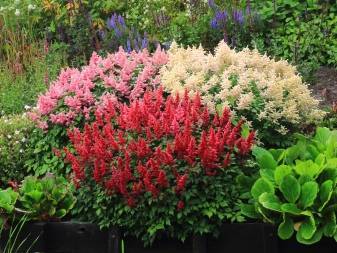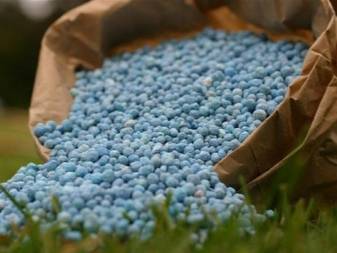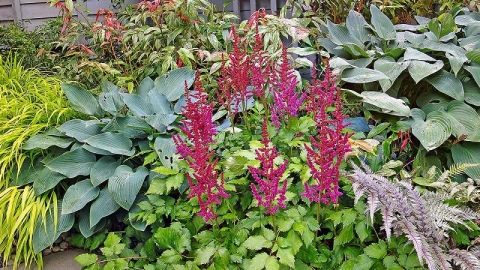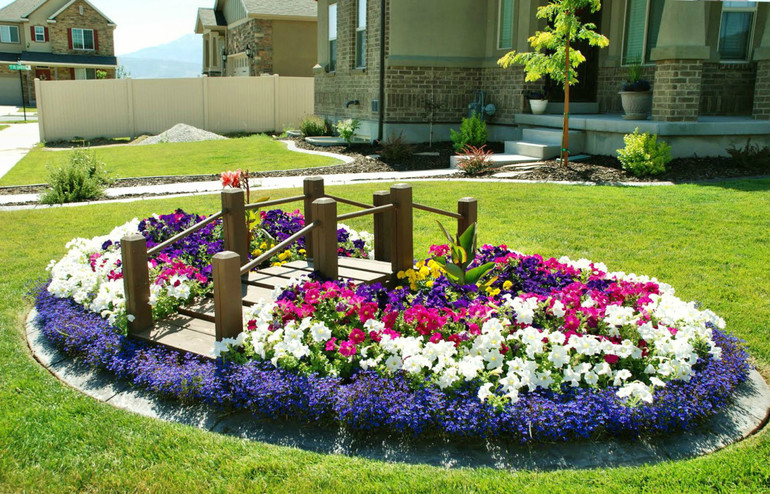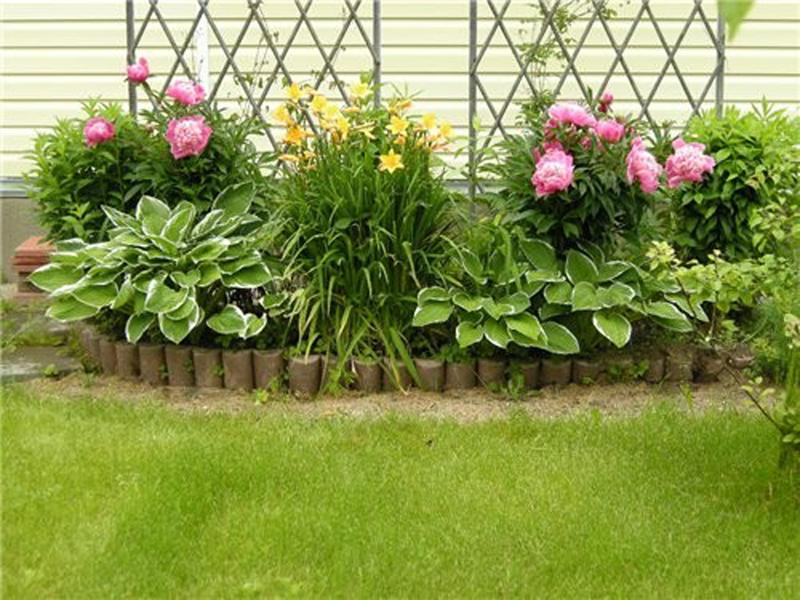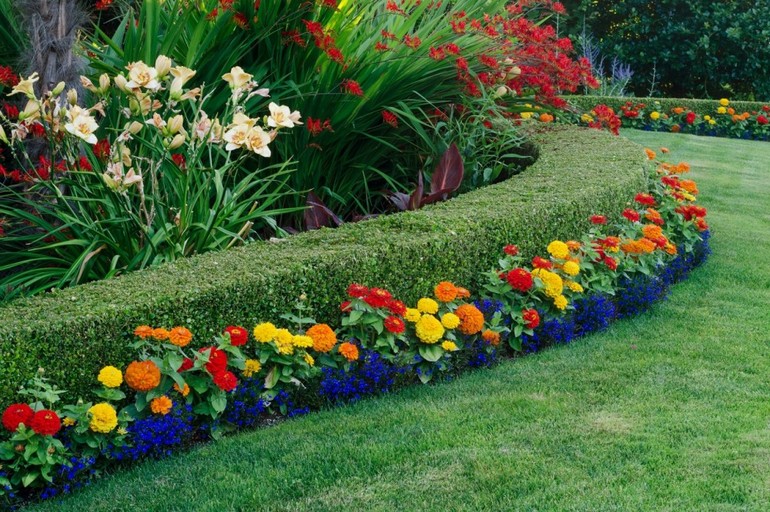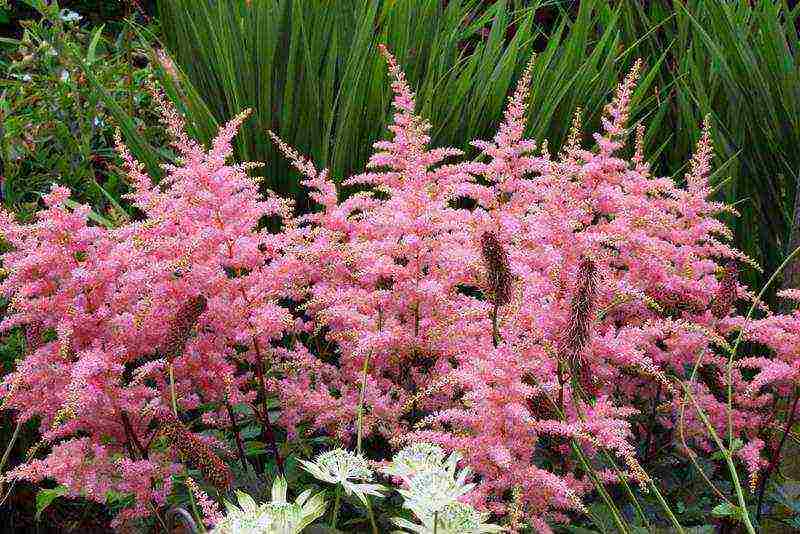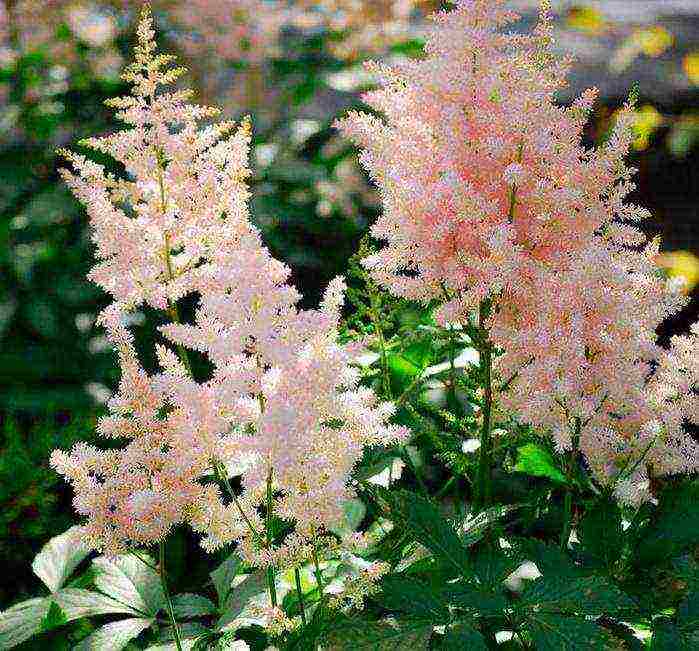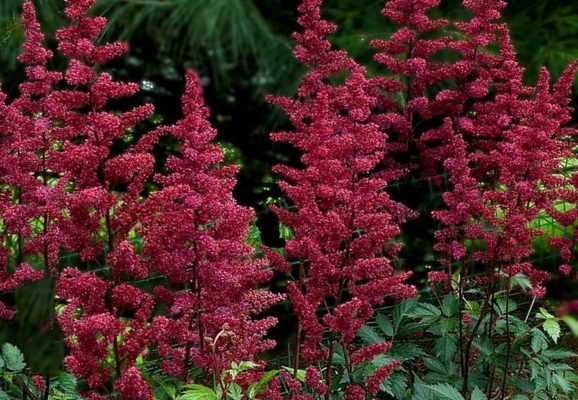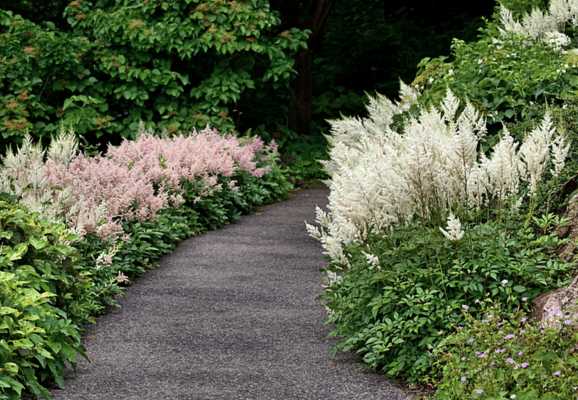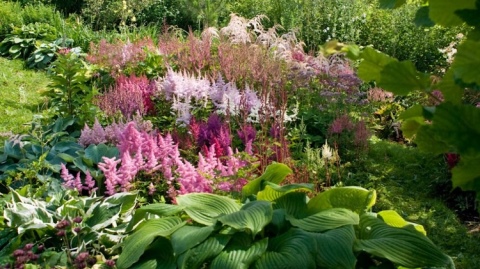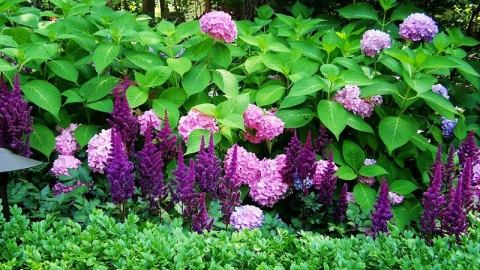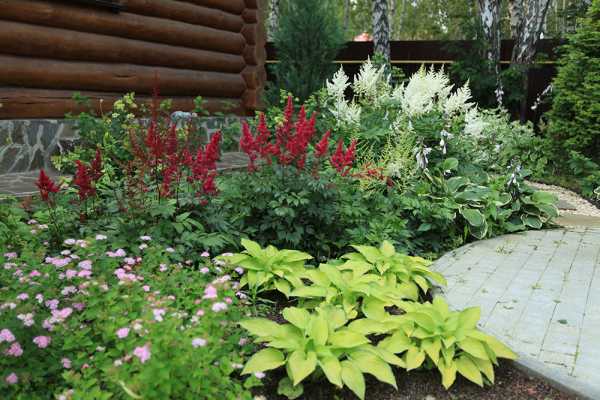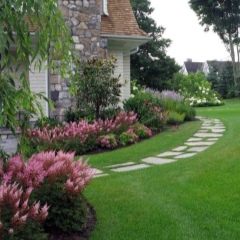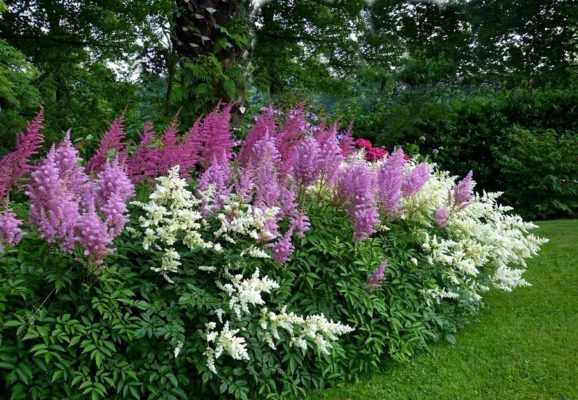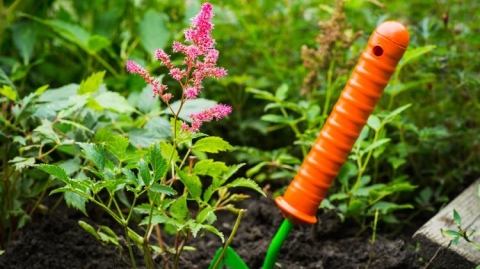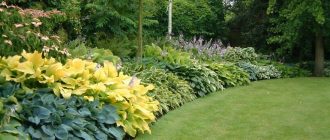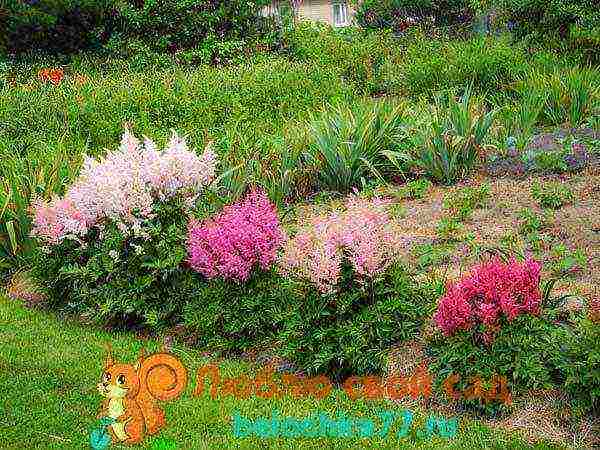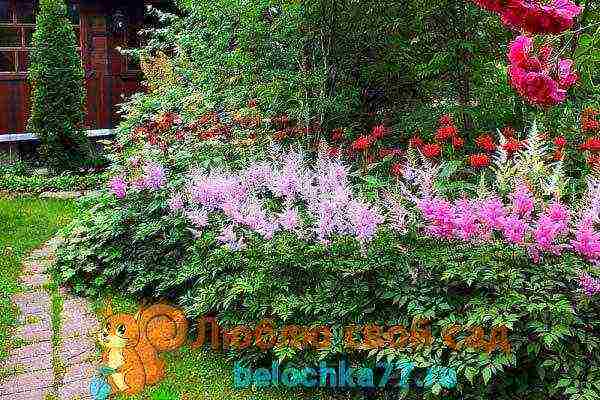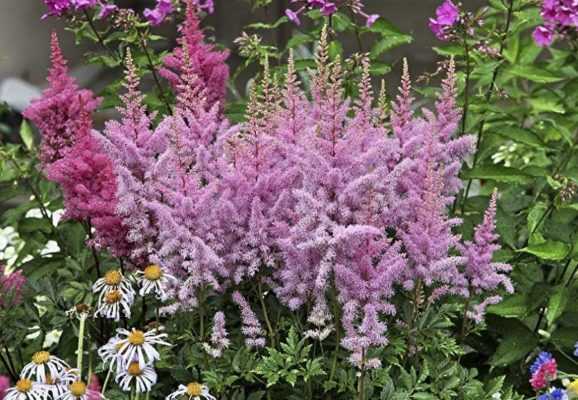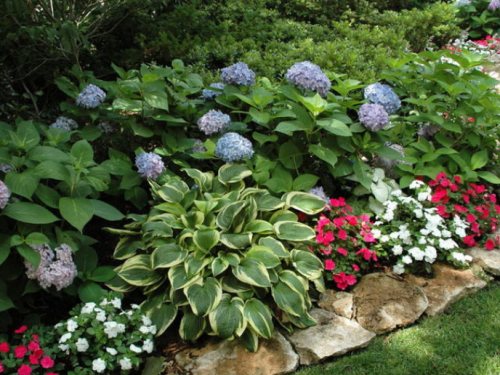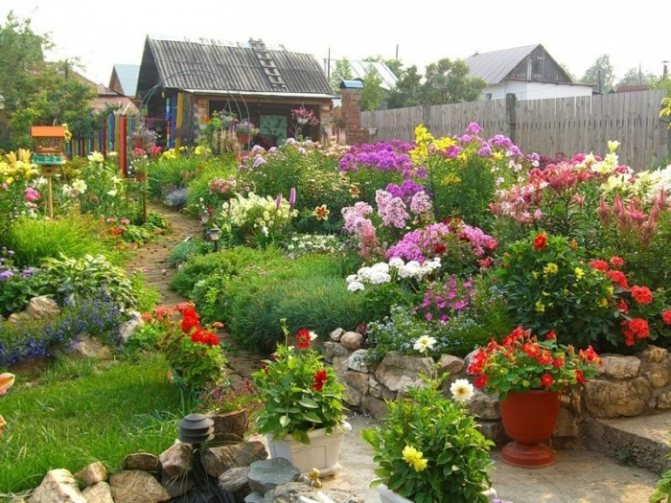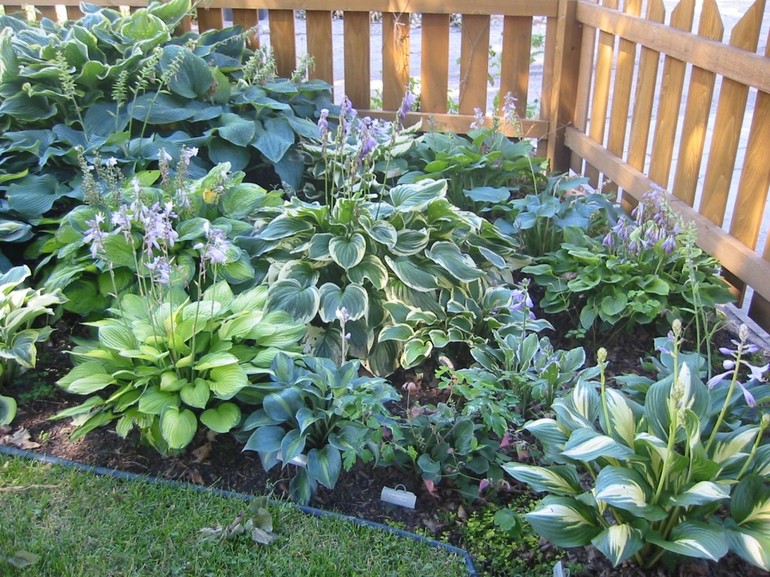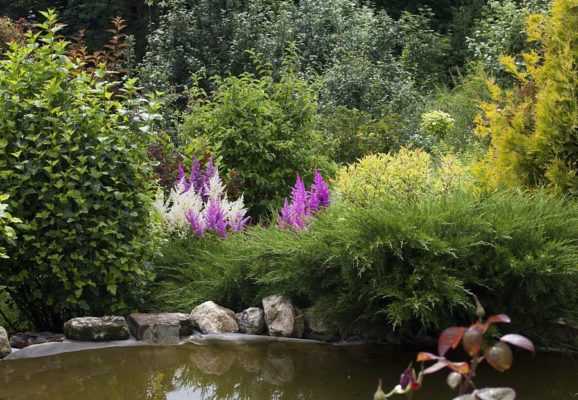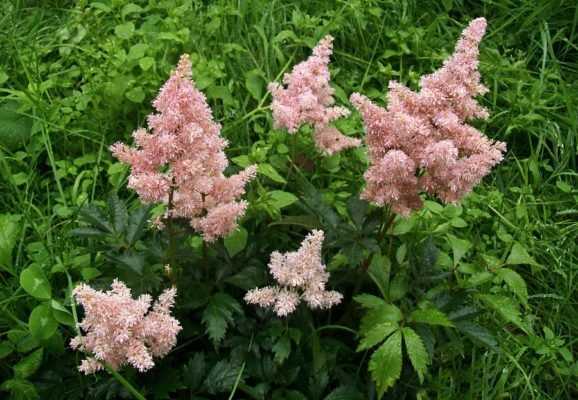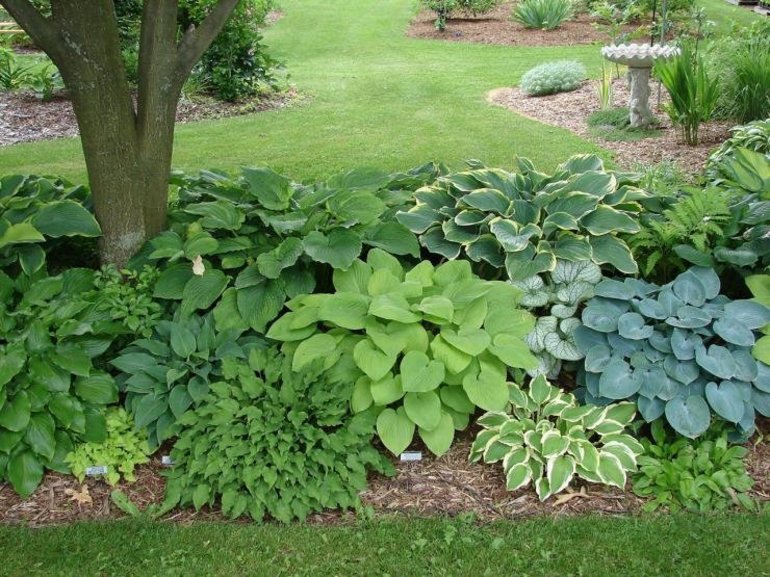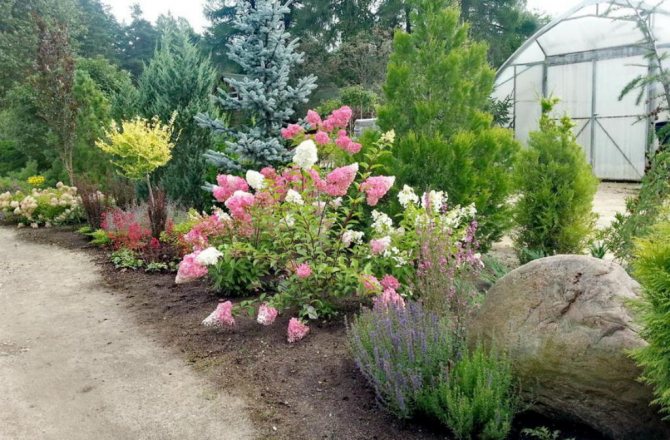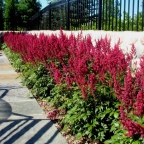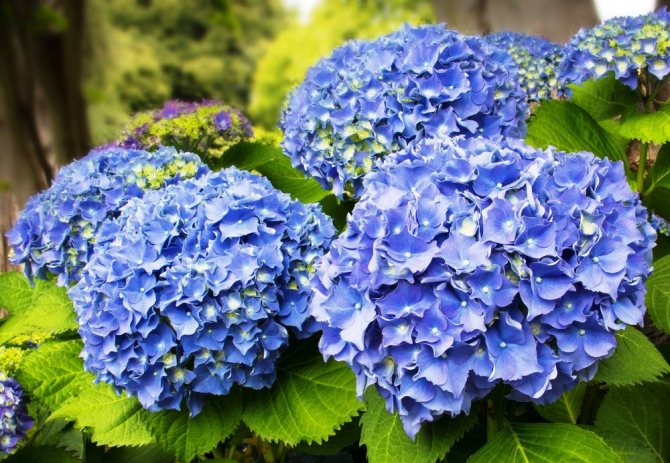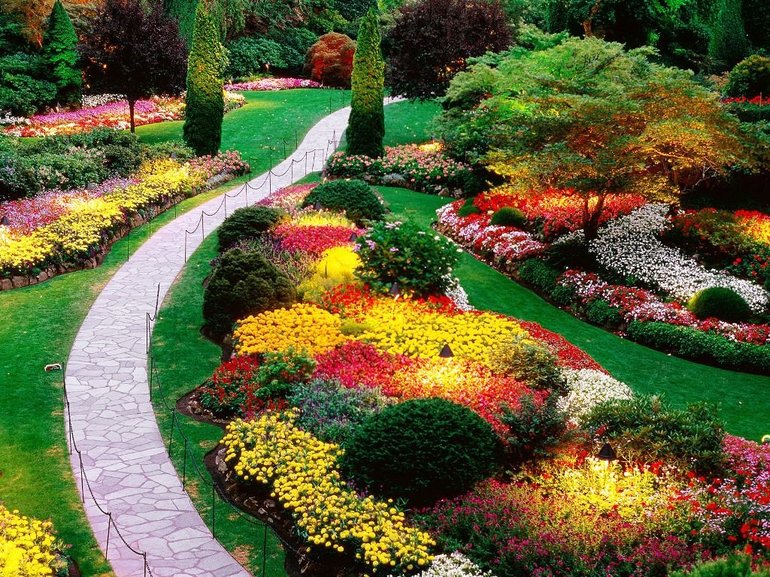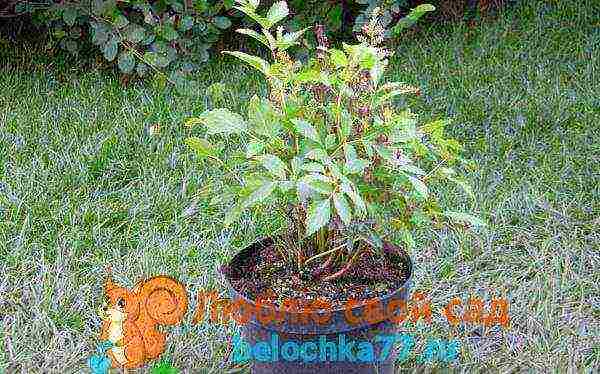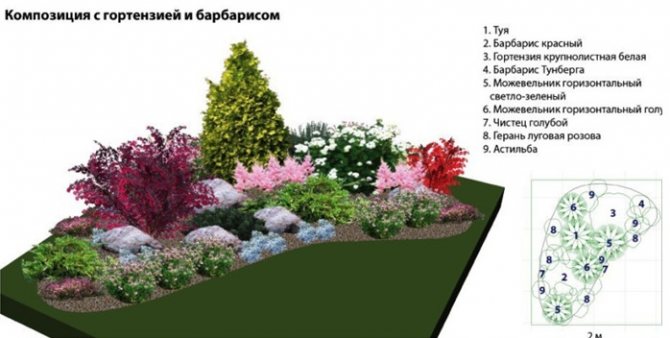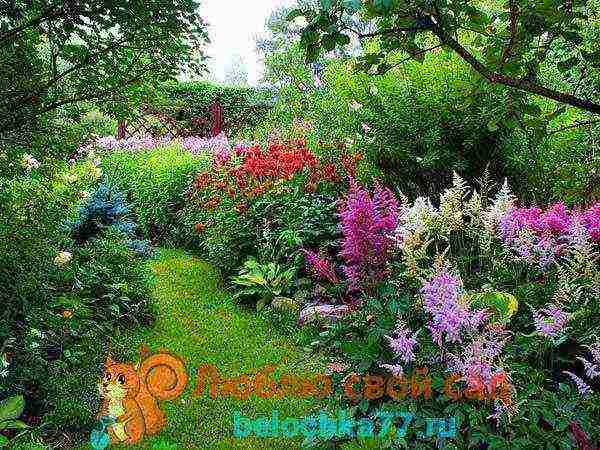The combination of astilba with other plants
To create a monochronic composition, you can plant a flower next to the following plants:
- Siberian white iris;
- Variegated iris;
- White dotted bells;
- Triangular oxalis.
Important! The hosta and astilba flower bed is the most common in the garden
Astilba and hosta in landscape design
Two plants - astilba next to the hosta - are used very often in landscape design, since both of these plants are similar in principles of care. They love water and shade. Calm and expressive hosta goes well with expressive astilba.
Flowerbeds with astilba and hosta
Such flower beds are unique: the brightly blooming astilba and the lush rosette of the hosts complement each other perfectly. Having landed this combination in a dark corner, you can decorate it advantageously.

Flowerbed with astilba and hosta
Hydrangea next to Astilba
Hydrangea, like astilba, loves moist soil. In this regard, they are often planted in the neighborhood. One of the advantages of such a composition is that after the flowers fall off, they will decorate the flower bed with beautiful decorative leaves.
Astilba is a beautiful flower that can be advantageously used in landscape design in combination with other plants.
Host in garden or park landscaping
Hosta leaves are of great value to designers. Thanks to these plants, they manage to create amazing landscapes. Hosts are often used as the backdrop for flower gardens, Japanese or English-style gardens.
And with the right approach, you can make this plant the central element of the composition.
Why is the hosta called the “queen” of gardeners?
- the plant is absolutely not whimsical. Withstands both shade and partial shade. Theoretically able to survive when exposed to direct sunlight, but it is better not to conduct such experiments;
- the host is a long-liver. It can grow and decorate one flower bed for over 20 years. The period of growth and green mass gain also depends on the variety;
- easily tolerates frost. She sheds her leaves and "goes" into the ground. Especially under snow, the root system is safe;
- does not require additional maintenance, a strict watering schedule or covering in the winter. It takes root well in summer cottages, where people do not live all year round and are only in season;
- the plant can withstand high humidity and dry soil. Only the shade of the leaves depends on the quality of the soil, especially the color saturation and the rate of green mass gain.
How are hosts used in garden design?
A bright flower bed in the country can be created using hostu and other bright flowers. It has fluffy bushes, more often a monochromatic base. Astilba looks win-win in landscape design. Astilba has large flowers that blend harmoniously with the volumes of the hosta leaves. Plants of this variety accentuate the fluffiness and volume of another plant. Astilba goes well with both low-growing hosts and plants of medium height and tall.
Geucheras and hosts in landscape design are often combined in one composition. Heuchera act as a link between hosts and other plants in the garden. Heuchera and stunted hosts look especially good when creating artificial reservoirs or on alpine slides.
Hosta varieties create additional options for growing these plants in the garden:
- multi-layer border element;
- live edging of a place to relax in the garden or near the gazebo;
- as a “pillow” near a vertical support;
- small, low hosts are perfect for decorating rose gardens, alpine slides, stone compositions;
- to create a mosaic design in the garden;
- creating a decor by planting flowers in special pots or metal buckets.
Description and varieties
Astilba is a very picturesque and vibrant plant with many inflorescences that can decorate any garden, lawn, flower garden and even a pond.It is known that in nature this perennial plant grows in many Asian countries, including Japan and China. Astilbe is also found in Mongolia. Astilba is also known as false spirea. In total, about thirty species of this plant are known with different leaves and inflorescences, as well as flowering periods.
For many years, Astilba has been actively used by gardeners and flower growers in the creation of unique landscape design, as a result of such popularity, breeders have bred many new varieties with an unusual color of inflorescences.
The plant is divided into special different groups, taking into account some criteria.
- Height. Astilba is dwarf, short, medium in height and tall. It is difficult to say which shrubs are most in demand, because, depending on preferences, several varieties of a given plant can be selected at the same time.
- Leaves color. The color can range from light green to dark green and even deep burgundy. The leaves themselves can be matte, glossy, shiny and even with a slightly pronounced fluff. The veins of openwork leaves are usually contrasting in relation to the main color. Even when the plant does not bloom, it is a real decoration of any garden.
- The color and size of the inflorescences. It can also be varied. The average size of the inflorescences is about 25-30 cm, the shape can be very original, for example, pyramidal. The color range is very wide, this plant can have cream, white, yellow, pink, crimson, purple and scarlet inflorescences. With such a wide choice, it is not difficult to give preference to one or another shade that is best suited for creating the perfect landscape design in the garden.
- Bloom. Astilba usually blooms in mid-summer. At least most of the varieties, but experts also know hybrids that can delight with their flowering already in the spring and even at the end of summer. That is, we can conclude that with the help of this plant, you can easily create regularly flowering flower beds that will delight the eye for a long time.
- Today gardeners know the sun-loving varieties of this plant and the shade-loving ones. However, most of them still prefer shady areas, in which plants bloom most actively and do not wither as quickly as under the rays of the scorching sun.
Myth 4. Roses in large quantities instantly decorate any garden
Roses take time to fully demonstrate their magnificence. Typically, the wait takes about three years. During this time, some amateur gardeners manage to become disillusioned with the variety, buying more and more new seedlings every year. But it is a delusion that the more roses the better. These flowers are too diverse and noticeable, which is why it is extremely difficult to fit them in one garden without breaking the harmony. A large number of flowers in different shades and heights often make the garden unkempt.
Many people plant roses under the window, which allows not only to enjoy the enchanting scent, but also to provide a wonderful backdrop for blooming beauties. In addition, the walls of the house additionally protect the plants from wind, frost or the scorching sun. However, don't plant roses too close. Flowers of different varieties require a certain distance from the fence or buildings. But on average, it is better to step back about half a meter if you want your plants to feel comfortable and not crowded around the facade.
It's also important to consider color matching. For example, a light wall will perfectly set off bright roses.
And white and pastel flowers will look good against the background of a dark fence.
Floribunda is suitable for creating hedges and looks good at the edge of the lawn. Climbing roses are worth choosing if you dream of a romantic gazebo, arch or pergola.
Hybrid tea roses are best suited for flower beds.And scrubs look good in group plantings, forming a beautiful blooming cloud.
Climbing, standard or ramblers: all about types of roses with descriptions and photos
Do you want to understand the names of roses? In our publication there is a catalog of different types, from climber to floribunda.
It is also difficult to combine roses with other plants. For example, rose bushes look very impressive next to clematis. But this neighborhood is unlikely to be comfortable if you plant these plants at the same time, because clematis is able to drown out the "aristocratic women" adjacent to it. Experienced gardeners advise you to plant rose seedlings first, and plant clematis after three years. Then the plants will develop on an equal footing.
Crocuses, primroses, violets, ageratum and some types of phlox will be good neighbors for roses. If you want to add accents, you can plant no more than three tall plants in the rose garden, for example, Chinese miscanthus, spartina, blue thunderbolt or reed grass. And if you want to add background plants, try using a cuff, geraniums, or undersized spireas.
What to plant next to roses?
Choosing the best neighbors for your favorite roses.
Astilba - planting and care in the open field
The impressive variety of the saxifrage family includes hardy and undemanding plants for the most part. Astilba needs to follow a few simple rules when planting and caring for it. The correct time and place of planting is a guarantee of healthy growth and splendor of the inflorescences.
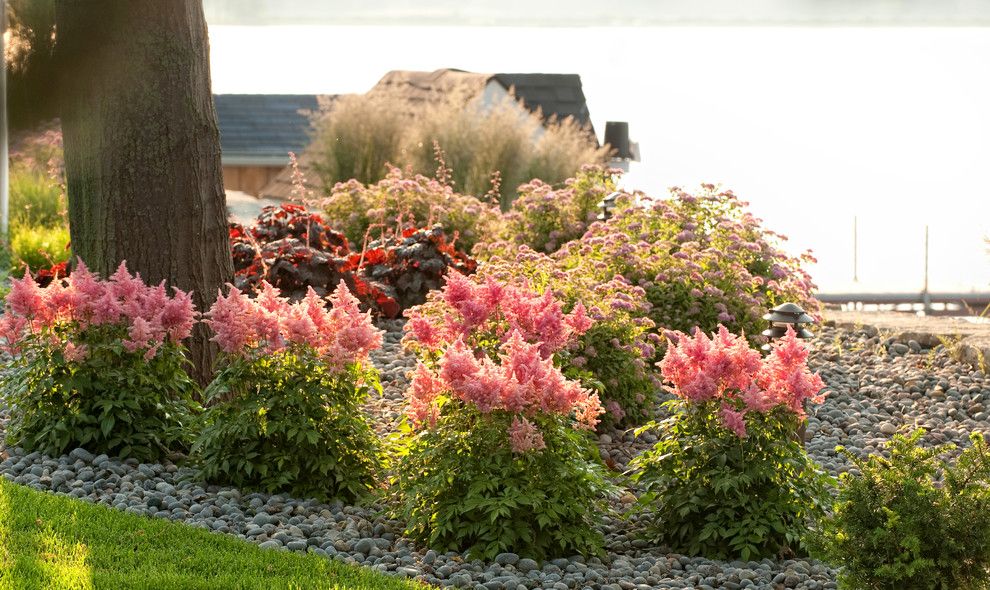
Delicate astilbe dusters make the garden more graceful
How to properly plant a purchased astilba in the garden
The best time to buy planting material is the first days of its availability. Due to the belonging of this flower to rhizome plants, there is a risk of pulling out the shoots during storage in the store. Also, shoots can dry out, rot in wet soil and be damaged during transportation, which often serves as the reason why astilbe does not bloom.
The main nuance is the preservation of the rhizome. A plant that has released shoots will take root, however, it will be weakened and in the first year it may have an unhealthy appearance. The purchase should be stored in the refrigerator until disembarking, the flower can withstand frosts down to -37 ° C.
Important! If the bush has already begun to wake up, it may die when it returns to cool conditions. It is recommended to land when the frost is gone.
This is the best time to transplant Astilba.
What you may need when landing
When planting, you will need mulch and organic fertilizers. This is the best way to feed Astilba. In the natural habitat of this flower, both wooded and swampy soils are located, while he most of all loves places near water bodies. The best option would be loose, humus-rich soil.
Important! If the soil has a high sand content, it may retain moisture worse, therefore, in this case, caring for astilba will require the use of a hydrogel
Where is the best place to plant astilba
This shrub does not tolerate direct sunlight, so shady areas of the garden are preferred. Ideal would be a combination of shade with a high-flowing underground current.
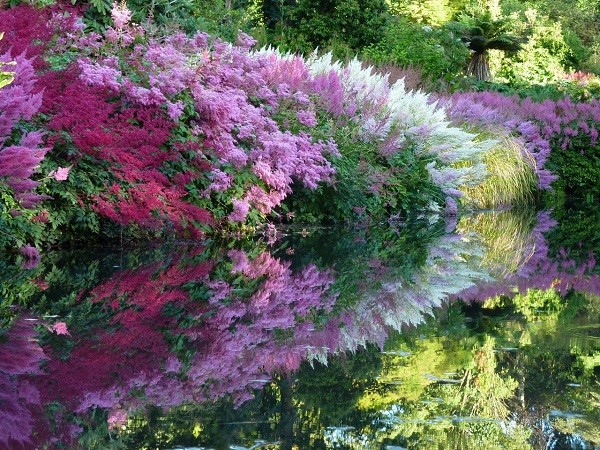
Astilba rewards creativity generously
The soil should be moist or often damp; most astilba species will not survive drought. pH 5.5–6.5 is a good acidity level. Drying out of the soil is one of the common reasons why Astilba leaves curl and dry. A positive factor will be the proximity of a fountain or pool. It is recommended to clear weeds and dig up the area before how to plant a flower.
Note! A separately planted astilbe bush does not have such splendor as a collection of its seedlings. This plant has long been used in landscape design; from its various varieties, multi-colored multi-level compositions are created.
Stages of the planting process
First, a deepening is made for the length of the rhizome of such a width that it fits freely there. If the seedling is in a pot, it must be pre-watered, and it should also be planted at a depth identical to its position.
The sprouts are planted at least 30 cm from each other, with a high grade the recommended distance reaches 50 cm.Organic fertilizers and hydrogel are introduced into the hole if necessary, after which it is covered with soil compacted at the roots, forming a circular lowland.
The flower is watered abundantly, while roots should not appear from the settled soil. The surroundings of the top with sprouts are generously sprinkled with mulch. Compost, sawdust, or bark are good options. In a dry climate, during the adaptation period of the plant, watering is performed every other day.
Additional Information. When planting and the necessary care, Astilba can grow without transplants and rejuvenation by dividing the bush for about 5 years.
A high agricultural background in combination with a sufficient level of moisture and nutrients in the soil will provide the shrub with decades of existence. Moderate nitrogen fertilization is recommended to stimulate foliage renewal in early spring.
Planting can also be done in soil pre-fertilized with organic matter (2 buckets / m2), in this case, the hole is fertilized with a large spoonful of mineral dressing and half a glass of ash.
With what to plant roses in a flower bed
Roses are very textured and bright. Neighboring flowers are always just an addition to them, they should only set off beauty.
With other colors
The combination with graceful clematis is one of the most successful. The flowering period of these plants completely coincides, and the requirements for their cultivation are almost the same. The only catch is that it is better to plant clematis after two years, so that it does not interfere with rooting. If the main flower has grown for more than three seasons in one place, a partition is needed between the roots. The distance between them should be one and a half meters.
- For varieties with a soft, yellow color, you need to select purple or purple clematis.
- To white - any shade from delicate blue to bright wine, depending on the artistic intent.
- Fuchsia, lilac, lilac, violet, purple are suitable for cream.
- On the other hand, light, neutral clematis are suitable for rich, red and burgundy seedlings.
Instagram @blagorodny_sad
Standard rose and clematis
Instagram @snilsa_mne_sad
Rose and blooming clematis
Instagram @ novikova.ludmila
Instagram @moi_chudecad
Other flowers for mixborder:
- Primroses.
- Ageratum.
- Crocuses.
- Violets.
- Phlox.
- Cuffs.
- Geranium.
- Silver wormwood.
- Bulbous primroses.
- Verbena.
- Stock-rose.
- Kosmeya.
- Levkoy.
- Bells.
- Gypsophila.
- Lupins.
- Lavender.
- Digitalis.
- Mahonia is holly.
- Pachisandra.
- Catnip.
- Marigold.
- Periwinkle.
Companion flowers should not create too dense thickets with high humidity. It is desirable that they are low and located at some distance from the main seedlings. They do not get along well with carnation, mignonette, peonies, hydrangeas, dahlias and buttercups.
Photo by Elsa Tornabene on Unsplash
Gypsophila
Instagram @sadovnitsa_anuta
In the foreground is the cuff
Instagram @blagorodny_sad
Yellow roses Floribunda, veronica spikelet and oak sage
Instagram @dom_s_rozami
With a Carpathian bell in the foreground
Instagram @dom_s_rozami
Delicate combination with alissum
Instagram @dom_s_rozami
Cold shades with Schmidt's wormwood
Instagram @dom_s_rozami
Astilba
With conifers and other ornamental shrubs
Flowerbeds with roses and conifers are not to every gardener's taste, but this combination is quite appropriate.Compact Christmas trees "Little Jam", "Gnome" pines, boxwoods, Japanese spireas, barberry, dwarf willows, thuja ("Western", "Smaragd", "Brabant", globular), junipers Skyrocket, Blue Arrow, Moonglow are suitable. Thanks to evergreens, the garden will delight even after flowering ends.
Shrubs can be located both in the center and act as a living curb. The distance between coniferous and main bushes should be at least 50 cm so that they do not interfere with each other's rooting.
Instagram @ natali.ns
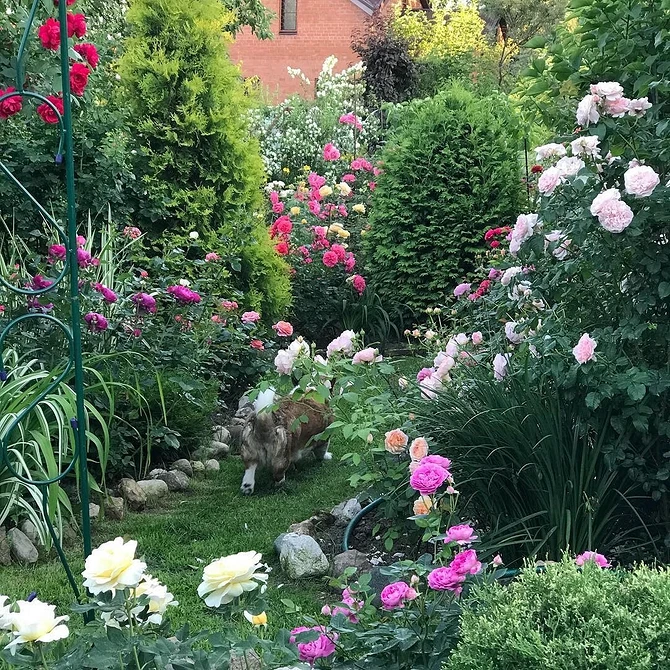
Instagram @galinaganzen
Rosary on the background of thuj
Instagram @alenkin_sad
Roses and boxwood
Instagram @kostya_koshelev
With other roses
Many gardeners prefer to design just such landscape objects. We have already written about the basic rules for arranging colors above. You can also use the online palette selection. It's a designers' tool, but why not apply it to your garden planning? Bright and large varieties are usually located in the center, and small ones at the edges. The landscape object must be proportionate to the plot.
Instagram @dom_s_rozami
Instagram @dom_s_rozami
Instagram @dom_s_rozami
Instagram @tatsianaalex
With herbs and grains
Also great companion plants. The composition with them turns out to be a little casual and natural. Perennial and annual grasses set off a bright base, decorate shaded corners. They are unpretentious in care. Hosts, ostrich (you need to limit the growth), low spike plants are suitable.
Instagram @blagorodny_sad
Instagram @stroikavradost
Instagram @ 22galikhay
Instagram @ 22galikhay
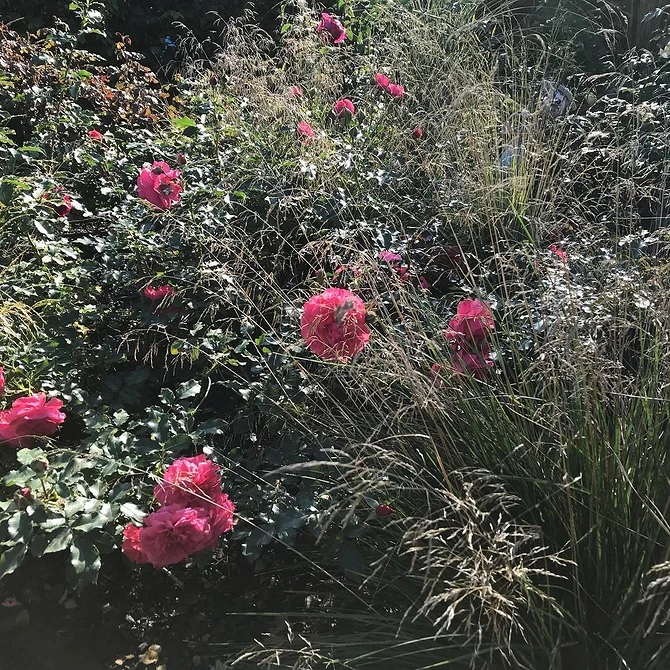
Instagram @ 22galikhay
Hostarium care
The main thing in caring for hosts is to ensure soil moisture where they grow. If this perennial does not have enough moisture, then its foliage will lose its decorative effect, the color will become less intense, the ends of the foliage will begin to darken. Therefore, timely watering is what gardeners should remember when caring for this lovely plant.
From time to time it is worth arranging evening showers for the plant. However, not all host species are suitable for such irrigation. Plants with blue foliage have a waxy coating on the foliage that can be easily washed off by moisture. And the foliage becomes unprotected from the harmful effects of the environment, and the wax itself gives the plant a blueness.
The plant also needs top dressing - alternation of organic and mineral fertilizers. Usually, fertilizers are applied under the host several times per season:
- in the spring, when the first foliage is just beginning to appear on a perennial;
- when the buds begin to open on the hosts;
- after the end of flowering.
Astilba: what to plant next to
Before deciding what to plant astilba in a flower bed with, it is worth understanding its features and studying the description. This plant is picturesque, bright, has numerous inflorescences. They can decorate a lawn, garden or flower garden. It is grown in Asia, Japan, China, Mongolia. It is also called "false spirea". In the selection of neighboring plants, it also matters, astilba is a shrub or flower.

What does astilba look like
Important! Astilba is loved by many gardeners, so about thirty varieties and species of this plant were bred
What leaves look like
Astilba leaves are complex, bipinnate. Some leaves have a heart-shaped base. They are shiny above and matte below. They look very unusual in bright sun. The foliage can also be rich olive, bronze and burgundy.
What does an astilbe flower look like
The plant belongs to the saxifrage family. The height, depending on the variety, can be from 20 to 200 cm. The flowering time of astilba is from June to September. The flowers thin out the delicate scent that is like bird cherry. The color of the petals can be white, pink, burgundy, red and lilac.
There are several forms of inflorescences:
- Drooping. The inflorescences are on a long and narrow stem. They sink to the ground, which looks especially graceful and sophisticated.
- In the form of a pyramid. The flanks with flowers have a perpendicular divergence to the central axis.These parts become thinner and shorter. The narrowing of the inflorescences occurs from the base to the crown.
- Paniculata. Here, too, there is a divergence of the lateral branches perpendicular to the axial, but they also strongly branch
- Rhombic. Branches with flowers grow at right angles and form a kind of rhombus.
Tall varieties
Tall varieties of astilba:
- Amethyst: a bush can grow up to 1 meter in height; the flowers are large, have a blue-violet color;
- Arends: grows up to 160 cm; large pink flowers;
- Pomegranate: grows up to two meters; the flowers are blood red;
- Diamond: grows up to 1.5 meters in height; the flowers are large and white;
- Ostrich feather: grows up to 80 cm; flowers have a lavender hue;
- Thunder and lightning: the height can reach 80 cm; small ruby flowers;
- Lavender: grows up to 1 meter; flowers are small, lavender in color.

A successful combination is obtained with such plants: lilies, daffodils, crocuses, tulips, hosts, junipers, ferns, conifers.
Important! In the first year after the plant has been planted, its leaves do not look very beautiful and luxurious. In this regard, snowdrops, hazel grouses, crocuses are planted nearby.
This is done to fill in the empty space.
Low-growing varieties
The undersized varieties of astilba include:
- Vision in red: height up to 30 cm. Flowers are small, bright purple. They have a strong aroma.
- Gloria: height 50 cm. Lush inflorescences in the form of a diamond. The flowers themselves are small and white.
- Europe: height up to 50 cm. Flowers are pale pink, odorless.
- Montgomery: height up to 70 cm. Flowers are pink and large.
- Purple Rhine: height up to 50 cm. Small purple-pink flowers.
What to plant next to an undersized astilba depends on the season. For example, in the spring it looks good with rhododendrons and iberis. The best combination of this plant is next to daylilies, hosts and incense. A good option is to plant it next to a rose. However, in this case, a certain distance is required.
Landing in open ground
In nature, the plant grows in places with constantly moist soil: on the banks of rivers, in deciduous forests, in mountainous areas. Therefore, it is preferable to pick up a corner in partial shade with moisture-consuming soil, where astilbe will grow well.
Planting plants in open ground is carried out in May - early June. First, you must carefully dig up the area and select the roots of the weeds. After that, you need to fertilize the soil with humus, compost or high-moor peat (2 buckets per 2 m?). After planting the plant in such a substrate, you will not need to feed for a long time.
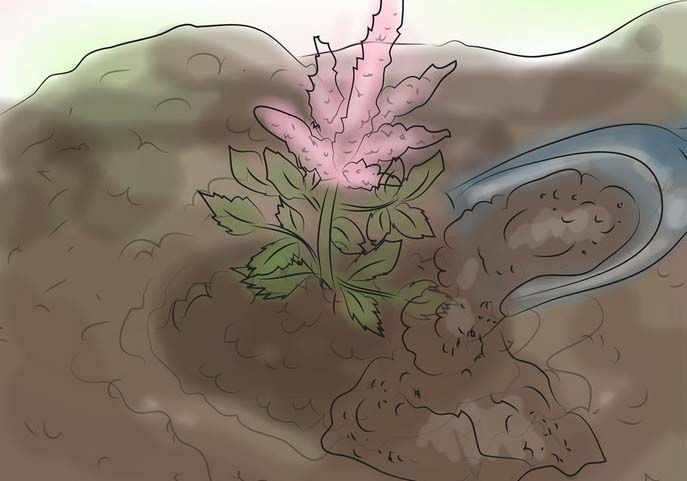
Prepare small pits about 20 cm deep. If you are planting several rhizomes, then place them at a distance of at least 40 cm from each other, since the bushes grow quickly.
At the bottom of each hole, put 1 tbsp. l. wood ash. If the soil on the site is not water-absorbing enough, then add a handful of hydrogel, which will help to retain moisture in the substrate.
Place the astilba rhizome in the middle of the hole and cover it with a nutritious substrate so that its layer is about 5 cm. If the plant has begun to grow, then plant it in such a way that the sprouts peep out above the soil surface. Water the plantings and mulch with sawdust, compost or peat. This mulch will help to retain moisture in the soil, which is very good for the development of astilba.
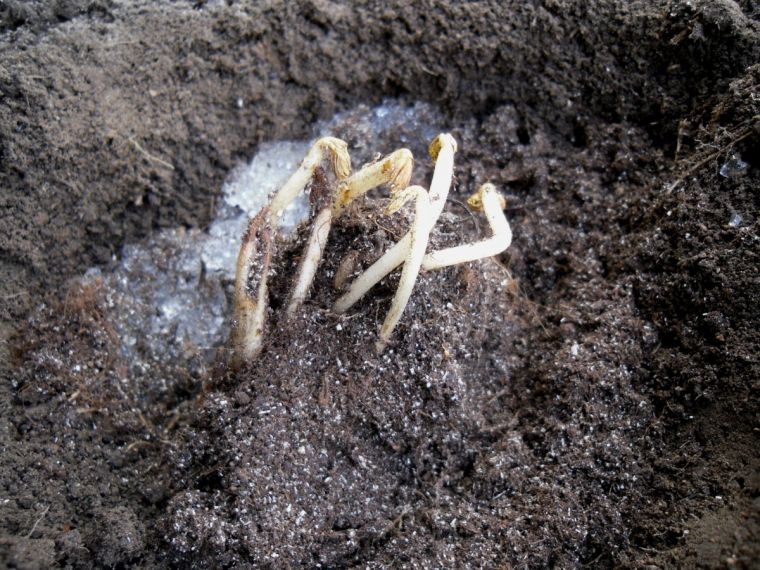
Astilba is a very unpretentious plant. Caring for him comes down to weeding while the flower is still small. Subsequently, when the bush grows enough, the need to weed the planting will disappear by itself. The curtains are so dense that weeds cannot germinate through them.
All varieties of astilba require a large amount of moisture. The plant needs regular and abundant watering. In dry periods, water in the morning and in the evening, and so that the moisture evaporates less, mulch the plantings thoroughly.
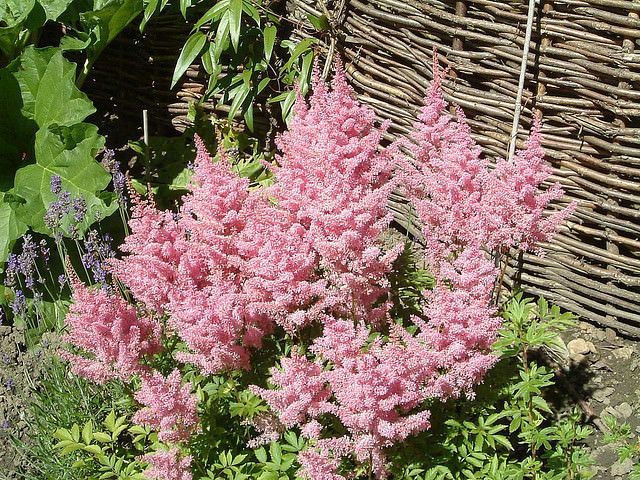
Inflorescences can be removed after flowering, although this is not necessary. Dried panicles are beautiful and can decorate a flower garden until frost. In October, the foliage and stems must be cut at soil level and the rhizomes must be covered with mulch. This will help protect the rhizomes of the flower from freezing. Young plantings of astilbe can be additionally covered with spruce branches, and such shelter is not required for adult plants.
Experienced flower growers recommend rejuvenating astilba plantings every 5 years. This can be done both in spring and autumn. The bush needs to be dug up and the rhizome divided into small divisions. The plant tolerates transplanting very well and blooms the next year.
General rules for caring for functions
Along with its design advantages, the host (it is also called a function) has one more undoubted advantage - it is unpretentious to care for. You need to follow a few simple recommendations:
- The plant needs watering only when dry, sultry weather is present for a week or more. A sure sign of the need to give additional moisture is cracked soil; water it abundantly, as the hosta loves a humid environment. It can also be planted along artificial reservoirs in the country.
- Different varieties have different attitudes towards the sun - some prefer partial shade, others prefer deep shading. This must be taken into account when growing.
- Hosta responds well to almost all types of fertilizers. Among organic ones, she loves compost soil, rotted leaves and pine bark. Among inorganic, it responds to nitrogen and phosphate. Even small top dressing ensures the rapid growth of hosts. Moreover, its flowers grow very large.
Important! You need to fertilize the hosts only in well-moistened soil. It is better to do this after heavy rains or after many days of abundant watering.
Further care
It is not difficult to take care of decorative astilba. The plant is very moisture-loving - watering should be done as often as possible. Even if you allow the soil to dry out for a short time, this can negatively affect the decorative properties of the plant when it blooms. Perhaps wilting of leaves, the appearance of smaller inflorescences, untidiness of the general appearance of the shrub.
During the year, astilbe shrubs give an increase of up to 3-5 cm. Caring for the plant is the timely filling of fertile soil under the bare roots. The soil layer is approximately 3 cm.
It is necessary to have mulch (peat, expanded clay, pieces of bark or special landscape crushed stone) on the soil layer. In winter, such a cover protects sensitive rhizomes from freezing.
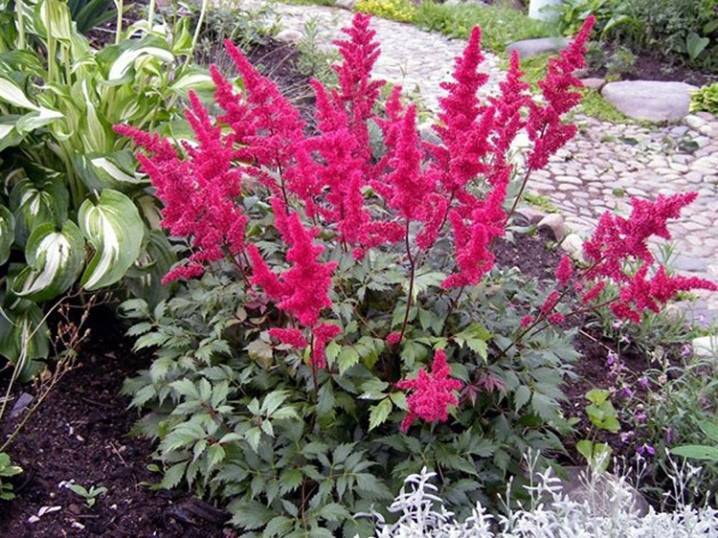
Timely watering and providing moisture in the soil guarantees a healthy plant and excellent decorative characteristics of the species when the shrub blooms. After the attractiveness of the bush is maintained by periodically cutting off dead stems and removing inflorescences that have withered after flowering
This is especially important when astilba is part of the landscape design.
In order for the plant to develop fully, it is necessary to regularly use fertilizing from complex fertilizers
Since without a transplant, a shrub can live in a permanent place for more than 5 years, and with the arrival of spring it is important to reinforce it with nitrogen fertilizer. It promotes the early regrowth of fresh foliage on bushes that have survived the winter.
It is necessary to take into account the fact that Astilba perfectly adapted to the Russian frosts, but the changeable temperature in spring can have a detrimental effect on the decorative culture.


During this period, it is important to take care of the wintering of the shrub, covering it with several layers of spruce branches on top. It is desirable that the soil between the bushes be covered with pine needles. The average lifespan of the astilba shrub is 5 years.
Then the plant is transplanted. It is permissible not to dig out the entire shrub, but to separate only a part, sprinkling the cut with ash and filling the resulting space with a fresh portion of soil
On average, the life expectancy of the astilba shrub is 5 years. Then the plant is transplanted. It is permissible not to dig out the whole shrub, but to separate only a part, sprinkling the cut with ash and filling the resulting space with a fresh portion of soil.
During flowering, astilbe needs phosphorus feeding, and by the end of flowering, fertilization with potassium is needed. Thus, the flowering period is extended, it becomes more luxuriant, full-fledged seeds are formed.
